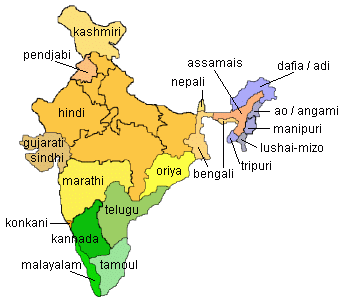
A MAP OF LINGUISTIC DIVERSITY
HOW IS FEDRALISM PRACTICED?
Costituional provisions are not the only key to the sucess of federalism in India but we have suceeded in this experiment because of the nature of democratic politics in our country.Respect for diversity and desire for living together became a shared ideal in our country.
HOW WE ENSURED FEDERALISM
LINGUISTIC STATES
It was the first & major step towards the democratic politics in our country.
--Since 1947 there have been many changes in the political map of India.
--many old states have vanished & new have been created.
--areas, boundaries and names of the states have been created.
Many old states have vanished & new states have been created.
--Areas , boundaries & names of the states have been changed.
--In 1947, the boundaries of several states were changed in order to create new states.This was done to ensure that people who spoke same language lived in the same state.
--Some states were created to recognize differences based on culture, ethinicity or geography.These included states like—Nagaland, Jharkhand & Uttarakhand.
Q. What has been the advantage of creating linguistic states?
When the demand for the formation of states on the basis of language was raised some leaders feared that it would lead to the disintegration of the country. Though central govt. resisted the linguistic states for some time but the experience has shown that linguistic states have actually made the country more united and it has made the administration easier.
LANGUAGE POLICY—
Our constitution has not given the status of national language to any one language
--Hindi was identified as an official language but Hindi is the mother tongue of only 40% of Indians, therefore there were many safeguards to protect other languages.
--Besides Hindi , there are 21 other languages recognized as Scheduled Languages by the constitution.
A candidate in an examination conducted for the central govt. position mau opt any of these languages.
-- the states too have their own official languages and much of the govt. work takes place in official language of the concerned state.
ENGLISH AND ITS USE—
Unlike SriLanka, the leaders of our country adopted a very catious attitude in spreading the use of Hindi.
ENGLISH LANGUAGE POLICY-According to the constitution the use of English for official purposes was to stop in 1965.
-- many non Hindi speaking states demanded the use of English to continue.
--in TamilNadu, this movement took a violent form and the Central government agreed to continue the use of English along with Hindi for official purposes.
--many critics think that this solution favoured the English speaking elite.
--promotion of Hindi continues to be the official policy of the government of India, but this does not mean that Central government can impose Hindi on states where people speak a different language.
Q. How our language policy is different from that of Sri Lanka?
A. Sri Lankan government followed a preferential policy towards Sinhalese language, disregarding Tamil. This resulted in lot of tensions and struggles in Sri Lanka.
Unlike Sri Lanka, our leaders adopted a flexible language policy to promote Hindi and continue English which has avoided the kind of situation Sri Lanka had.
STATE- CENTRE RELATIONS IN INDIA:
Restructuring of state- centre relations depend upon the federalism i.e., sharing of power between state and centre. How the constitutional arrangements for power sharing works in reality depends upon to a large extent on how ruling parties and leaders follow these arrangements.
--In India for a long time , same party ruled both at centre & states. This meant that state govts. did not exercise their rights as autonomous federal units .
--When ruling party at state level was different,, the parties that ruled the center tried to undermine the power of states. In those days central govt. would often misuse the constitution to dismiss the state govts. that were controlled by rival parties. This undermined the sprit of federalism.
--All this changed significantly after 1990. Their was a rise of regional poltical parties in many states of the country & this was also the era of the Coalition Govts. at the center.
--Since no single party got clear majority in Lok sabha the major national parties had to enter into an alliance with many parties including many several regional parties to form govt. at the center.
--This led to a new culture of power sharing & respect for the autonomy of the state govt. This trend was supported by the supreme court’s judgement which made it difficult for the Central govt. to dismiss state govts. in an arbitrary manner. Thus power sharing is more effective today than it was in the early years after the constitution came into force.
LINGUISTIC DIVERSITY OF INDIA
Q. India is the most diverse country of the world in terms of languages. Discuss.
According to the census held in 1991:
--the census recorded more than 1500 distinct languages which people mentioned as mother tongues.These languages were grouped under some major languages (.For example-Bhojpuri, Magadhi, Bundelkhandi, Chattisgarhi, Rajasthani, Bhili and many others were grouped under Hindi).
--even after this grouping census found 114 languages.
--22 languages are included in the Eight Schedule of the constitution & are called Scheduled Languages and others are called Non-Scheduled Languages.
Status of Hindi:
The largest language, Hindi is the mother tongue of only about 40% Indians
--all those who knew Hindi as their second or third language, the total number was still than less than 50% in 1991.
Status of English:
Only 0.02% of Indians recorded it as their mother tongue.
--other 11% knew it as a second or third language.


No comments:
Post a Comment